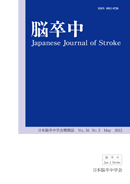29 巻, 6 号
選択された号の論文の54件中1~50を表示しています
第32回日本脳卒中学会講演抄録
会長講演
-
2007 年 29 巻 6 号 p. 669-673
発行日: 2007/11/25
公開日: 2009/02/06
PDF形式でダウンロード (1180K)
理事長講演
-
2007 年 29 巻 6 号 p. 674-679
発行日: 2007/11/25
公開日: 2009/02/06
PDF形式でダウンロード (1056K)
招待講演1
-
2007 年 29 巻 6 号 p. 680
発行日: 2007/11/25
公開日: 2009/02/06
PDF形式でダウンロード (62K)
招待講演2
-
2007 年 29 巻 6 号 p. 681
発行日: 2007/11/25
公開日: 2009/02/06
PDF形式でダウンロード (64K)
シンポジウムI
-
2007 年 29 巻 6 号 p. 682
発行日: 2007/11/25
公開日: 2009/02/06
PDF形式でダウンロード (71K) -
2007 年 29 巻 6 号 p. 683-687
発行日: 2007/11/25
公開日: 2009/02/06
PDF形式でダウンロード (1149K) -
2007 年 29 巻 6 号 p. 688-693
発行日: 2007/11/25
公開日: 2009/02/06
PDF形式でダウンロード (480K) -
2007 年 29 巻 6 号 p. 694
発行日: 2007/11/25
公開日: 2009/02/06
PDF形式でダウンロード (61K) -
2007 年 29 巻 6 号 p. 695-698
発行日: 2007/11/25
公開日: 2009/02/06
PDF形式でダウンロード (1065K) -
2007 年 29 巻 6 号 p. 699-702
発行日: 2007/11/25
公開日: 2009/02/06
PDF形式でダウンロード (298K) -
2007 年 29 巻 6 号 p. 703
発行日: 2007/11/25
公開日: 2009/02/06
PDF形式でダウンロード (54K) -
2007 年 29 巻 6 号 p. 704-710
発行日: 2007/11/25
公開日: 2009/02/06
PDF形式でダウンロード (1944K)
シンポジウムII
-
2007 年 29 巻 6 号 p. 711
発行日: 2007/11/25
公開日: 2009/02/06
PDF形式でダウンロード (58K) -
2007 年 29 巻 6 号 p. 712
発行日: 2007/11/25
公開日: 2009/02/06
PDF形式でダウンロード (60K) -
2007 年 29 巻 6 号 p. 713
発行日: 2007/11/25
公開日: 2009/02/06
PDF形式でダウンロード (50K) -
2007 年 29 巻 6 号 p. 714
発行日: 2007/11/25
公開日: 2009/02/06
PDF形式でダウンロード (64K) -
2007 年 29 巻 6 号 p. 715-720
発行日: 2007/11/25
公開日: 2009/02/06
PDF形式でダウンロード (432K) -
2007 年 29 巻 6 号 p. 721-725
発行日: 2007/11/25
公開日: 2009/02/06
PDF形式でダウンロード (1933K)
シンポジウムIII
-
2007 年 29 巻 6 号 p. 726
発行日: 2007/11/25
公開日: 2009/02/06
PDF形式でダウンロード (58K) -
2007 年 29 巻 6 号 p. 727-730
発行日: 2007/11/25
公開日: 2009/02/06
PDF形式でダウンロード (787K) -
2007 年 29 巻 6 号 p. 731
発行日: 2007/11/25
公開日: 2009/02/06
PDF形式でダウンロード (53K) -
2007 年 29 巻 6 号 p. 732
発行日: 2007/11/25
公開日: 2009/02/06
PDF形式でダウンロード (57K) -
2007 年 29 巻 6 号 p. 733
発行日: 2007/11/25
公開日: 2009/02/06
PDF形式でダウンロード (58K) -
2007 年 29 巻 6 号 p. 734
発行日: 2007/11/25
公開日: 2009/02/06
PDF形式でダウンロード (55K) -
2007 年 29 巻 6 号 p. 735-739
発行日: 2007/11/25
公開日: 2009/02/06
PDF形式でダウンロード (935K)
シンポジウムIV
-
2007 年 29 巻 6 号 p. 740
発行日: 2007/11/25
公開日: 2009/02/06
PDF形式でダウンロード (64K) -
2007 年 29 巻 6 号 p. 741
発行日: 2007/11/25
公開日: 2009/02/06
PDF形式でダウンロード (58K) -
2007 年 29 巻 6 号 p. 742-747
発行日: 2007/11/25
公開日: 2009/02/06
PDF形式でダウンロード (3122K) -
2007 年 29 巻 6 号 p. 748-752
発行日: 2007/11/25
公開日: 2009/02/06
PDF形式でダウンロード (1995K) -
2007 年 29 巻 6 号 p. 753
発行日: 2007/11/25
公開日: 2009/02/06
PDF形式でダウンロード (45K) -
2007 年 29 巻 6 号 p. 754
発行日: 2007/11/25
公開日: 2009/02/06
PDF形式でダウンロード (46K) -
2007 年 29 巻 6 号 p. 755-758
発行日: 2007/11/25
公開日: 2009/02/06
PDF形式でダウンロード (1934K)
シンポジウムV
-
2007 年 29 巻 6 号 p. 759
発行日: 2007/11/25
公開日: 2009/02/06
PDF形式でダウンロード (60K) -
2007 年 29 巻 6 号 p. 760
発行日: 2007/11/25
公開日: 2009/02/06
PDF形式でダウンロード (57K) -
2007 年 29 巻 6 号 p. 761
発行日: 2007/11/25
公開日: 2009/02/06
PDF形式でダウンロード (60K) -
2007 年 29 巻 6 号 p. 762-766
発行日: 2007/11/25
公開日: 2009/02/06
PDF形式でダウンロード (1082K) -
2007 年 29 巻 6 号 p. 767-770
発行日: 2007/11/25
公開日: 2009/02/06
PDF形式でダウンロード (1640K) -
2007 年 29 巻 6 号 p. 771-776
発行日: 2007/11/25
公開日: 2009/02/06
PDF形式でダウンロード (465K) -
2007 年 29 巻 6 号 p. 777-781
発行日: 2007/11/25
公開日: 2009/02/06
PDF形式でダウンロード (1930K)
合同シンポジウムI (脳卒中・脳卒中の外科)
-
2007 年 29 巻 6 号 p. 782
発行日: 2007/11/25
公開日: 2009/02/06
PDF形式でダウンロード (60K) -
2007 年 29 巻 6 号 p. 783-788
発行日: 2007/11/25
公開日: 2009/02/06
PDF形式でダウンロード (1459K) -
2007 年 29 巻 6 号 p. 789-793
発行日: 2007/11/25
公開日: 2009/02/06
PDF形式でダウンロード (1374K) -
2007 年 29 巻 6 号 p. 794-798
発行日: 2007/11/25
公開日: 2009/02/06
PDF形式でダウンロード (407K) -
2007 年 29 巻 6 号 p. 799-804
発行日: 2007/11/25
公開日: 2009/02/06
PDF形式でダウンロード (2311K) -
2007 年 29 巻 6 号 p. 805-809
発行日: 2007/11/25
公開日: 2009/02/06
PDF形式でダウンロード (1661K) -
2007 年 29 巻 6 号 p. 810
発行日: 2007/11/25
公開日: 2009/02/06
PDF形式でダウンロード (48K) -
2007 年 29 巻 6 号 p. 811-815
発行日: 2007/11/25
公開日: 2009/02/06
PDF形式でダウンロード (268K)
合同シンポジウムII (脳卒中・脳卒中の外科)
-
2007 年 29 巻 6 号 p. 816
発行日: 2007/11/25
公開日: 2009/02/06
PDF形式でダウンロード (54K) -
2007 年 29 巻 6 号 p. 817
発行日: 2007/11/25
公開日: 2009/02/06
PDF形式でダウンロード (55K) -
2007 年 29 巻 6 号 p. 818
発行日: 2007/11/25
公開日: 2009/02/06
PDF形式でダウンロード (63K)
